Well, here we go... this file is all one chunk and will take a
while to load over a slow connection.
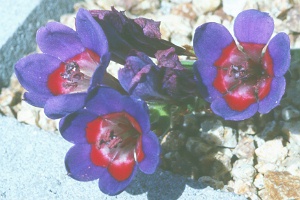
Babiana
rubrocyanea
One of the showiest of the Babianas, also known as "Wine
Cups" or "Baboon flowers"; baboons are said to eat the corms. Reliable
outdoors in the Bay Area.

Ferraria crispa
I always think of this flower as 'baroque'. This species can be quite
robust, up to perhaps two feet tall, producing in succession many flowers which
last one day each. To me, they smell strongly of Mennen's Anti-Fungal Foot
Powder, and flies are very attracted to them. It's very amusing to see the
flies wandering around with their backs bright orange from the pollen of
this species: when a fly in the yard shows this adornment, I can tell this
flower is in bloom.
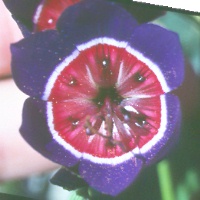
Geissorhiza radians
I've heard these called both "Wine Cups" and "Sequins". I think that you
will have to agree that this is a pretty spectacular flower. They are
about an inch across, held no more that 4 to 6 inches off the ground on
inconspicuous grassy foliage. I suspect that most of the Geissorhizas do in
fact require a dry summer. I can't think of a nicer 'jewel' to stick in a
well-drained crevice in a rock garden!
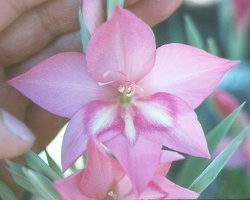
Gladiolus carmineus
One of the many Gladiolus species that you don't find in florists' or
commercial nurseries. This lovely plant is basically a hysteranthous fall
bloomer, i.e. the flowers appear without much foliage at the end of summer.
They will take water during the summer, and appreciate a bit of shade.

Gladiolus stefaniae
This is one of my all-time favorite South African bulbs. The flowers are
almost as large as a hybrid Glad, and the color to me is unbeatable. They
are also fall bloomers. They are about as shocking an event as the bulb
garden can produce: appearing above the dry surface of the bed like little
crimson explosions before almost any other plants have woken up. Truly a
'must have!'
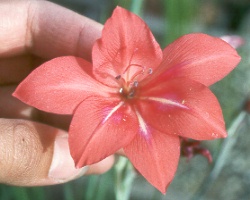
Gladiolus stefaniae
Another form of this fabulous South African.
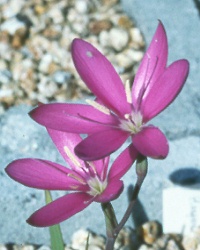
Hesperantha pauciflora
The generic name here means "evening-flower" and in fact most of these open
either in the afternoon or evening. The plants are tiny, and the flowers
large; a good combination in my book. I suspect these also are obligate
dry summer plants. The corms have a very amusing shape, like little buoys
or land mines.
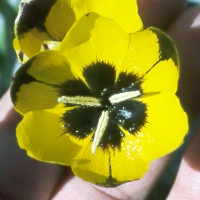
Hesperantha vaginata
These are shockers, and the color is very unusual for the genus, but in
leaf and flower morphology they are otherwise typical Hesperanthas. They
grow easily and abundantly for me.
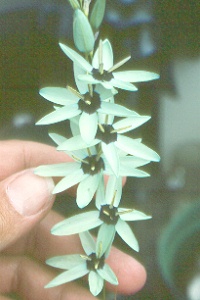
Ixia viridiflora
This sea-green Ixia is justly famous. The color is very rare in a flower,
and the contrast between the perhaps aquamarine outer part of the flower
and the purple, almost black, center is striking. These seem to tolerate
summer water, but also thrive where they bake dry.
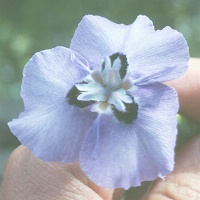
Moraea calcicola
The Moraeas are close relatives of the fortnight lily and show more clearly
than many of the other irids their relationship to true irises.
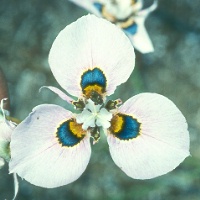
Moraea villosa
Probably the best-known of the genus: easy to grow, prolific and beautiful.
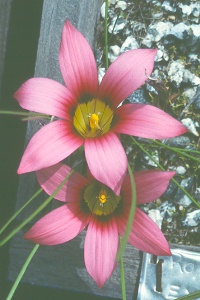
Romulea eximia
This genus is basically a southern extension of the European genus Crocus,
and the plants are quite similar in most respects. The foliage is always
grasslike. These plants are showy, easy, hardy and will naturalize in a
suitable spot outside.

Romulea monadelpha
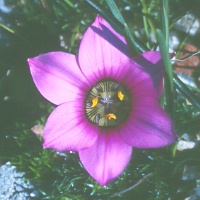
Romulea subfistulosa
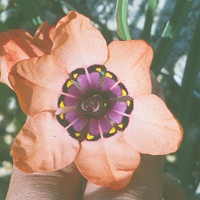
Sparaxis elegans
Hybrids of this genus are often called "Harlequin Flowers".
Very adaptable outside here.
Click here
to return to the home page of this site;
Click here
to return to the bulb introduction page.
Website design and content Copyright © 1998, 2007 Paul Leondis














